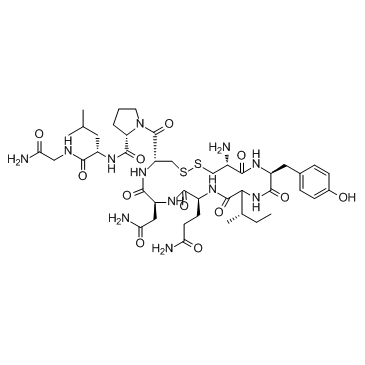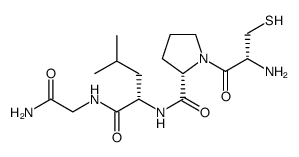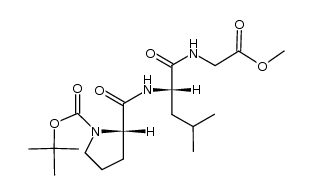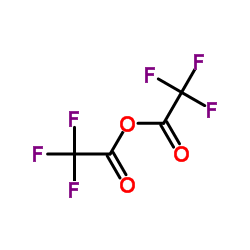50-56-6
| Name | Oxytocin |
|---|---|
| Synonyms |
Pitocin
Synpitan α-Hypophamine Oxytocic hormone Oxystin L-Cysteinyl-L-tyrosyl-L-isoleucyl-L-glutaminyl-L-asparaginyl-L-cysteinyl-L-prolyl-L-leucylglycinamide cyclic (1®6)-disulfide Uteracon Syntocinone MFCD00076731 EINECS 200-048-4 (2S)-1-({(4R,7S,10S,13S,16S,19R)-19-amino-7-(2-amino-2-oxoethyl)-10-(3-amino-3-oxopropyl)-16-(4-hydroxybenzyl)-13-[(1S)-1-methylpropyl]-6,9,12,15,18-pentaoxo-1,2-dithia-5,8,11,14,17-pentaazacycloicosan-4-yl}carbonyl)-N-{(1S)-1-[(2-amino-2-oxoethyl)carbamoyl]-3-methylbutyl}pyrrolidine-2-carboxamide 1-{[(4R,7S,10S,13S,16S,19R)-19-Amino-7-(2-amino-2-oxoethyl)-10-(3-amino-3-oxopropyl)-13-[(2S)-2-butanyl]-16-(4-hydroxybenzyl)-6,9,12,15,18-pentaoxo-1,2-dithia-5,8,11,14,17-pentaazacycloicosan-4-yl]carbonyl}-L-prolyl-L-leucylglycinamide α-Hypophamine Oxtocin Nobitocin S 1-{[(4R,7S,10S,13S,16S,19R)-19-Amino-7-(2-amino-2-oxoethyl)-10-(3-amino-3-oxopropyl)-13-[(2S)-butan-2-yl]-16-(4-hydroxybenzyl)-6,9,12,15,18-pentaoxo-1,2-dithia-5,8,11,14,17-pentaazacycloicosan-4-yl]carbonyl}-L-prolyl-L-leucylglycinamide Atonin O Syntocinon Di-sipidin Glycinamide, 1-[[(4R,7S,10S,13S,16S,19R)-19-amino-7-(2-amino-2-oxoethyl)-10-(3-amino-3-oxopropyl)-16-[(4-hydroxyphenyl)methyl]-13-[(1S)-1-methylpropyl]-6,9,12,15,18-pentaoxo-1,2-dithia-5,8,11,14,17-pentaazacycloeicos-4-yl]carbonyl]-L-prolyl-L-leucyl- Presoxin Syntocin Utedrin Partocon Oxytocin Acetate |
| Description | Oxytocin (α-Hypophamine) is a mammalian neurohypophysial hormone; its actions are mediated by specific, high-affinity oxytocin receptors; ligand of oxytocin receptor. |
|---|---|
| Related Catalog | |
| References |
| Density | 1.3±0.1 g/cm3 |
|---|---|
| Boiling Point | 1533.3±65.0 °C at 760 mmHg |
| Melting Point | 192-194°C |
| Molecular Formula | C43H66N12O12S2 |
| Molecular Weight | 1007.187 |
| Flash Point | 881.1±34.3 °C |
| Exact Mass | 1006.436462 |
| PSA | 450.13000 |
| LogP | -4.26 |
| Vapour Pressure | 0.0±0.3 mmHg at 25°C |
| Index of Refraction | 1.554 |
| Storage condition | 2-8°C |
|
Section 1. Chemical Product and Company Identification Oxytocin Common Name/ Trade Name Manufacturer Oxytocin Section 4. First Aid Measures Eye ContactCheck for and remove any contact lenses. In case of contact, immediately flush eyes with plenty of water for at least 15 minutes. Cold water may be used. Get medical attention if irritation occurs. Skin ContactWash with soap and water. Cover the irritated skin with an emollient. Get medical attention if irritation develops. Cold water may be used. Serious Skin ContactNot available. InhalationIf inhaled, remove to fresh air. If not breathing, give artificial respiration. If breathing is difficult, give oxygen. Get medical attention. Serious InhalationNot available. IngestionIf swallowed, do not induce vomiting unless directed to do so by medical personnel. Never give anything by mouth to an unconscious person. Loosen tight clothing such as a collar, tie, belt or waistband. Get medical attention immediately. Serious IngestionNot available. Section 5. Fire and Explosion Data Flammability of the Product May be combustible at high temperature. Auto-Ignition Temperature Not available. Flash PointsNot available. Flammable LimitsNot available. These products are carbon oxides (CO, CO2), nitrogen oxides (NO, NO2...), sulfur oxides (SO2, SO3...). Products of Combustion Fire Hazards in Presence of Slightly flammable to flammable in presence of heat. Various Substances Explosion Hazards in Presence Risks of explosion of the product in presence of mechanical impact: Not available. of Various SubstancesRisks of explosion of the product in presence of static discharge: Not available. Fire Fighting MediaSMALL FIRE: Use DRY chemical powder. and InstructionsLARGE FIRE: Use water spray, fog or foam. Do not use water jet. Special Remarks onAs with most organic solids, fire is possible at elevated temperatures. Fire HazardsMaterial in powder form, capable of creating a dust explosion. Special Remarks on Explosion Fine dust dispersed in air in sufficient concentrations, and in the presence of an ignition source is a potential dust Hazardsexplosion hazard. Section 6. Accidental Release Measures Small SpillUse appropriate tools to put the spilled solid in a convenient waste disposal container. Finish cleaning by spreading water on the contaminated surface and dispose of according to local and regional authority requirements. Large Spill Poisonous solid. Stop leak if without risk. Do not get water inside container. Do not touch spilled material. Use water spray to reduce vapors. Prevent entry into sewers, basements or confined areas; dike if needed. Eliminate all ignition allow to evacuate through the sanitary system. Oxytocin Section 7. Handling and Storage PrecautionsKeep away from heat. Keep away from sources of ignition. Ground all equipment containing material. Do not ingest. Do not breathe dust. Wear suitable protective clothing. If ingested, seek medical advice immediately and show the container or the label. StorageKeep container tightly closed. Keep container in a cool, well-ventilated area. Do not store above 8°C (46.4°F). Refrigerate. Section 8. Exposure Controls/Personal Protection Engineering ControlsUse process enclosures, local exhaust ventilation, or other engineering controls to keep airborne levels below recommended exposure limits. If user operations generate dust, fume or mist, use ventilation to keep exposure to airborne contaminants below the exposure limit. Personal ProtectionSafety glasses. Lab coat. Dust respirator. Be sure to use an approved/certified respirator or equivalent. Gloves. Personal Protection in Case of Splash goggles. Full suit. Dust respirator. Boots. Gloves. A self contained breathing apparatus should be used a Large Spillto avoid inhalation of the product. Suggested protective clothing might not be sufficient; consult a specialist BEFORE handling this product. Exposure LimitsNot available. Section 9. Physical and Chemical Properties Physical state and appearance Solid. (Powdered solid.)OdorNot available. TasteNot available. Molecular Weight1007.19 g/mole ColorWhite. Off-white. pH (1% soln/water)Not available. Not available. Boiling Point Melting PointNot available. Not available. Critical Temperature Specific GravityNot available. Vapor PressureNot applicable. Vapor DensityNot available. VolatilityNot available. Odor ThresholdNot available. Water/Oil Dist. Coeff.Not available. Ionicity (in Water)Not available. Dispersion PropertiesSee solubility in water. SolubilitySoluble in cold water. Soluble in 1-Butanol and 2-Butanol Section 10. Stability and Reactivity Data StabilityThe product is stable. Not available. Instability Temperature Conditions of InstabilityExcess heat Incompatibility with variousNot available. substances CorrosivityNot available. Oxytocin Special Remarks onNot available. Reactivity Special Remarks onNot available. Corrosivity PolymerizationWill not occur. Section 11. Toxicological Information Routes of EntryInhalation. Ingestion. Toxicity to AnimalsAcute oral toxicity (LD50): >20.52 mg/kg [Rat]. Chronic Effects on Humans Not available. Other Toxic Effects onSlightly hazardous in case of skin contact (irritant), of ingestion, of inhalation. Humans Special Remarks on Not available. Toxicity to Animals Special Remarks onMay cause adverse reproductive effects and birth defects (teratogenic) Chronic Effects on Humans Special Remarks on otherAcute Potential Health Effects: Toxic Effects on HumansSkin: May cause skin irritation. Eyes: May cause eye irritation. Inhalation: Dust may cause respiratory tract irritation. Ingestion: May be harmful if swallowed. May cause flushing, headache, somnolence, nausea and vomiting. May also cause hypotension followed by hypertension, bradycardia, tachycardia, arteriospasm, fluid and electrolyte imbalance, and possible seizures. It may also affect the kidneys. Blurred vision and conjunctival hemorrhage, anxiety, difficulty breathing are rare complications. Chronic Potential Health Effects: Ingestion: Prolonged or repeated ingesiton may cause allergic (anaphylactoid) reaction. Note: Uterine rupture or tears may result from high dose Oxytocin. The use of Oxytocin to induce labor may result in intrauterine transplacental hyponatremia which may cause neonatal seizures and respiratory depression. It may also cause neonatal hyperbilirubinemia and jaundice (effects on the liver). Section 12. Ecological Information Not available. Ecotoxicity Not available. BOD5 and COD Products of BiodegradationPossibly hazardous short term degradation products are not likely. However, long term degradation products may arise. Toxicity of the ProductsThe products of degradation are less toxic than the product itself. of Biodegradation Not available. Special Remarks on the Products of Biodegradation Section 13. Disposal Considerations Waste DisposalWaste must be disposed of in accordance with federal, state and local environmental control regulations. Oxytocin Section 14. Transport Information DOT ClassificationNot a DOT controlled material (United States). IdentificationNot applicable. Not applicable. Special Provisions for Transport DOT (Pictograms) Section 15. Other Regulatory Information and Pictograms No products were found. Federal and State Regulations CaliforniaCalifornia prop. 65: This product contains the following ingredients for which the State of California has found to cause cancer which would require a warning under the statute: No products were found. Proposition 65 Warnings California prop. 65: This product contains the following ingredients for which the State of California has found to cause birth defects which would require a warning under the statute: No products were found. Other RegulationsOSHA: Hazardous by definition of Hazard Communication Standard (29 CFR 1910.1200). EINECS: This product is on the European Inventory of Existing Commercial Chemical Substances (EINECS No. 200-048-4). Canada: Listed on Canadian Domestic Substance List (DSL). China: Not listed on National Inventory. Japan: Listed on National Inventory (ENCS). Korea: Not listed on National Inventory (KECI). Philippines: Not listed on National Inventory (PICCS). Australia: Listed on AICS. WHMIS (Canada) CLASS D-2A: Material causing other toxic effects (VERY TOXIC). Other Classifications DSCL (EEC)R22- Harmful if swallowed.S46- If swallowed, seek medical advice immediately and show this container or label. Health Hazard HMIS (U.S.A.)1 National Fire Protection 1 Flammability 1 Association (U.S.A.) Fire Hazard 1 0 Reactivity Health Reactivity 0 Specific hazard Personal Protection E WHMIS (Canada) (Pictograms) DSCL (Europe) (Pictograms) TDG (Canada) (Pictograms) Oxytocin ADR (Europe) (Pictograms) Protective Equipment Gloves. Lab coat. Dust respirator. Be sure to use an approved/certified respirator or equivalent. SECTION 16 - ADDITIONAL INFORMATION N/A |
CHEMICAL IDENTIFICATION
HEALTH HAZARD DATAACUTE TOXICITY DATA
|
| Hazard Codes | Xi: Irritant; |
|---|---|
| Risk Phrases | R36/37/38 |
| Safety Phrases | 26-36 |
| RIDADR | 3249 |
| WGK Germany | 3 |
| RTECS | RS7534000 |
| Packaging Group | II |
| Hazard Class | 6.1(a) |
|
~99% 
50-56-6 |
| Literature: Tovi, Avi; Eidelman, Chaim; Shushan, Shimon; Elster, Shai; Alon, Hagi; Ivchenko, Alexander; Butilca, Gabriel-Marcus; Zaovi, Gil Patent: US2006/148699 A1, 2006 ; Location in patent: Page/Page column 11 ; |
|
~% 
50-56-6 |
| Literature: Wang, Ting; Danishefsky, Samuel J. Journal of the American Chemical Society, 2012 , vol. 134, # 32 p. 13244 - 13247 |
|
~% 
50-56-6 |
| Literature: Wang, Ting; Danishefsky, Samuel J. Journal of the American Chemical Society, 2012 , vol. 134, # 32 p. 13244 - 13247 |
|
~% 
50-56-6 |
| Literature: Wang, Ting; Danishefsky, Samuel J. Journal of the American Chemical Society, 2012 , vol. 134, # 32 p. 13244 - 13247 |
|
~% 
50-56-6 |
| Literature: Wang, Ting; Danishefsky, Samuel J. Journal of the American Chemical Society, 2012 , vol. 134, # 32 p. 13244 - 13247 |
| Precursor 3 | |
|---|---|
| DownStream 1 | |






